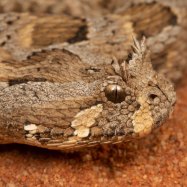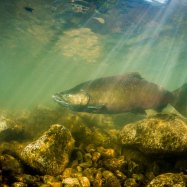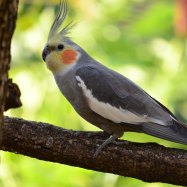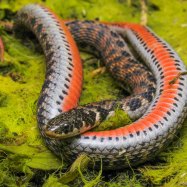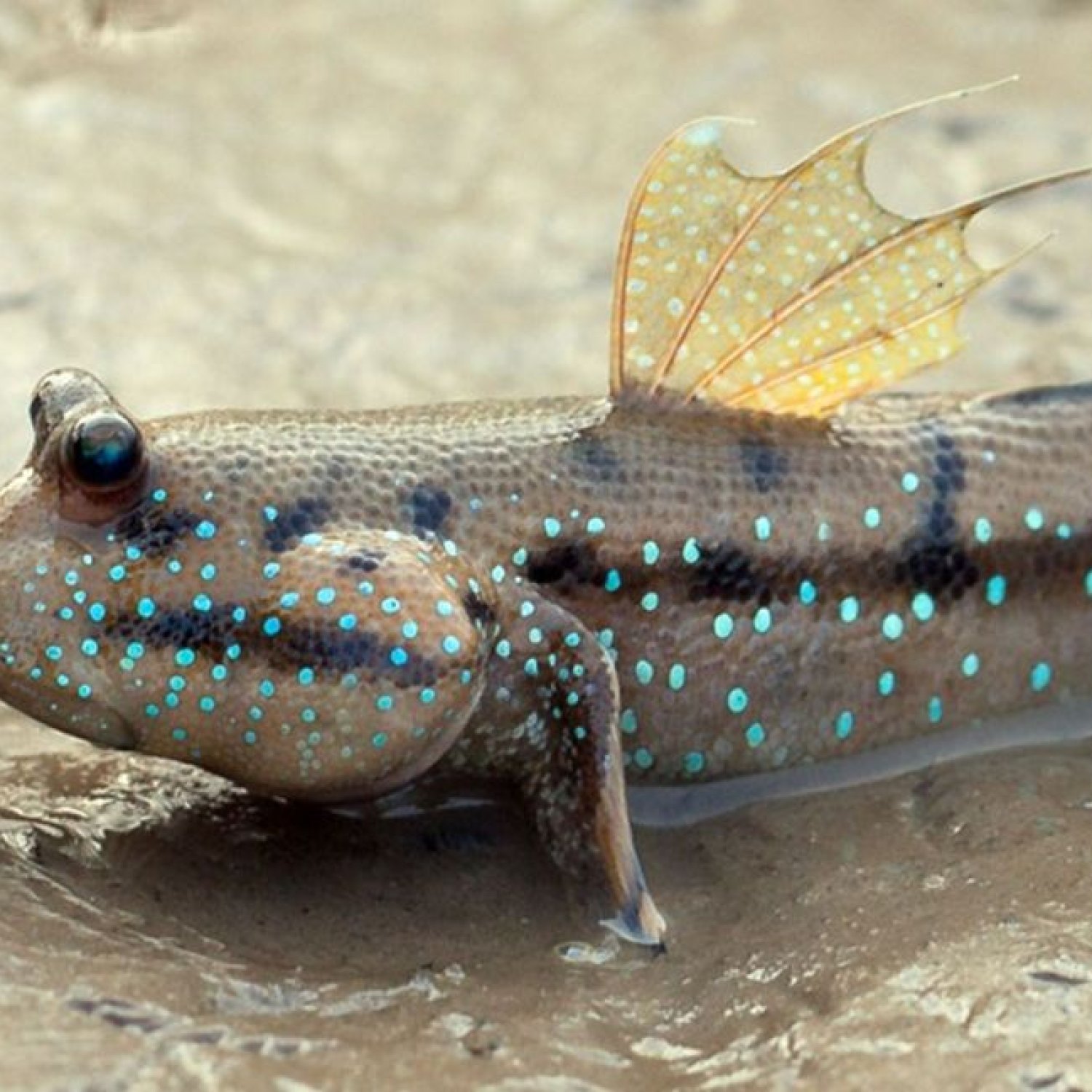
Mudskipper
Between 6 and 30 centimeters
The mudskipper, belonging to the Gobiidae family, is a small aquatic animal found in muddy areas like mudflats, mangroves, estuaries, and swamps. With a slender body, large pectoral fins, and eyes, they can grow between 6 and 30 centimeters in length. These unique creatures can survive both on land and in water, making them fascinating animals to observe in their natural habitats. #mudskipper #aquaticanimals #Gobiidaefamily
Animal Details Summary:
Common Name: Mudskipper
Kingdom: Animalia
Habitat: Mangrove forests and intertidal mudflats
Mudskippers: The Incredible Amphibious Fish
When you think of fish, the image of a slippery, scaly creature swimming in water probably comes to mind. However, there is one type of fish that defies this stereotype and will leave you amazed - the Mudskipper. These unique and fascinating creatures have adapted to survive in both water and land, making them one of the most interesting fish species in the world. In this article, we will take a closer look at the Mudskipper, its incredible features, and how it has evolved to become the ultimate amphibious fish Mudskipper.The Basics of the Mudskipper
Scientifically known as Periophthalmus, the Mudskipper belongs to the Animalia kingdom and the Chordata phylum. It is a member of the class Actinopterygii, which includes all ray-finned fish. Mudskippers are a species of fish that belong to the Gobiiformes order and the Gobiidae family. They are found in various countries, predominantly in tropical and subtropical regions, and have been observed in Asia, Africa, and Australia.Living on the Edge: Habitat and Distribution
Mudskippers are commonly found in mangrove forests and intertidal mudflats, making them truly unique creatures. These habitats are characterized by muddy and swampy areas, providing the perfect environment for mudskippers to thrive in. They are also known to live in estuaries and swamps, where brackish water (a mixture of freshwater and seawater) is abundant.Mudskippers are found in a wide geographical distribution, and each species has its own preferred range. In Asia, they can be found in Indonesia, Japan, Malaysia, and Thailand, among other countries Mink. In Africa, they have been spotted in Madagascar, Mozambique, and Tanzania. In Australia, they have been observed in Queensland and the Northern Territory.
A Diet Made for Survival: Feeding Methods
Mudskippers have adapted to their unique habitat and have developed a feeding method that allows them to survive in both water and land. They are omnivorous, meaning they consume both plant and animal matter. In water, they feed on small crustaceans, insects, and worms, while on land, they feed on algae, decomposing organic material, and insects.What truly sets mudskippers apart from other fish is their ability to climb trees. They use their strong pectoral fins to propel themselves and quickly move from one tree to another. This gives them access to a wider variety of food sources, making them efficient hunters.
The Ultimate Escape Artist: Body Shape and Coloration
Mudskippers have a slender body with a flattened head, which makes them perfectly suited for their intertidal habitat. Their head is broader than their body, and they have large eyes that sit on top of their head, giving them a wide field of vision. This helps them navigate in their ever-changing environment and keep a lookout for potential predators.Their body is usually around 6 to 30 centimeters in length, depending on the species. However, what truly stands out is their remarkable ability to change color. Mudskippers are generally brown, gray, or green in color, but they can change their hue to match their surroundings. This is a survival mechanism that helps them blend in and avoid being seen by predators.
The Evolution of an Amphibious Fish
Mudskippers have evolved to become true amphibious fish, capable of surviving in both water and land. This unique adaptation can be traced back millions of years, but it wasn't fully understood until recently. Scientists have discovered that mudskippers have lungs and gills, allowing them to breathe both underwater and on land.When mudskippers are on land, they rely on their lungs for oxygen and use their gills mainly for breathing underwater. However, when they are in water, they use their gills to extract oxygen from the water and supplement it with air gulped at the surface. This dual breathing mechanism is essential for survival in their habitat, where tides constantly change the water level.
Another remarkable adaptation of mudskippers is their ability to maintain their body temperature despite the changing environment. They adjust their body temperature by moving between water and the air, helping them regulate their body temperature and stay active.
The Mudskipper's Unique Reproduction Process
Apart from their physical adaptations, mudskippers have also developed a unique reproduction process. Unlike most fish that lay eggs to reproduce, mudskippers give birth to live young. The female mudskipper will bury herself into the muddy substrate and lay her eggs. The male will then guard the eggs until they hatch, keeping them safe from predators. Once the eggs hatch, the male will lead the newly hatched mudskippers to the water, where they will continue to develop.Conclusion
In conclusion, the Mudskipper is a truly remarkable creature that has captured the interest and curiosity of scientists and nature enthusiasts worldwide. Their ability to survive in both water and land, their unique adaptations, and their unusual reproductive process make them fascinating subjects for study. As we continue to explore the depths of our planet, it is creatures like the mudskipper that remind us of the endless diversity and adaptability of life on Earth.

Mudskipper
Animal Details Mudskipper - Scientific Name: Periophthalmus
- Category: Animals M
- Scientific Name: Periophthalmus
- Common Name: Mudskipper
- Kingdom: Animalia
- Phylum: Chordata
- Class: Actinopterygii
- Order: Gobiiformes
- Family: Gobiidae
- Habitat: Mangrove forests and intertidal mudflats
- Feeding Method: Omnivorous
- Geographical Distribution: Tropical and subtropical regions
- Country of Origin: Found in various countries
- Location: Mudflats, mangroves, estuaries, and swamps
- Animal Coloration: Brown, gray, green
- Body Shape: Slender with large pectoral fins and eyes
- Length: Between 6 and 30 centimeters
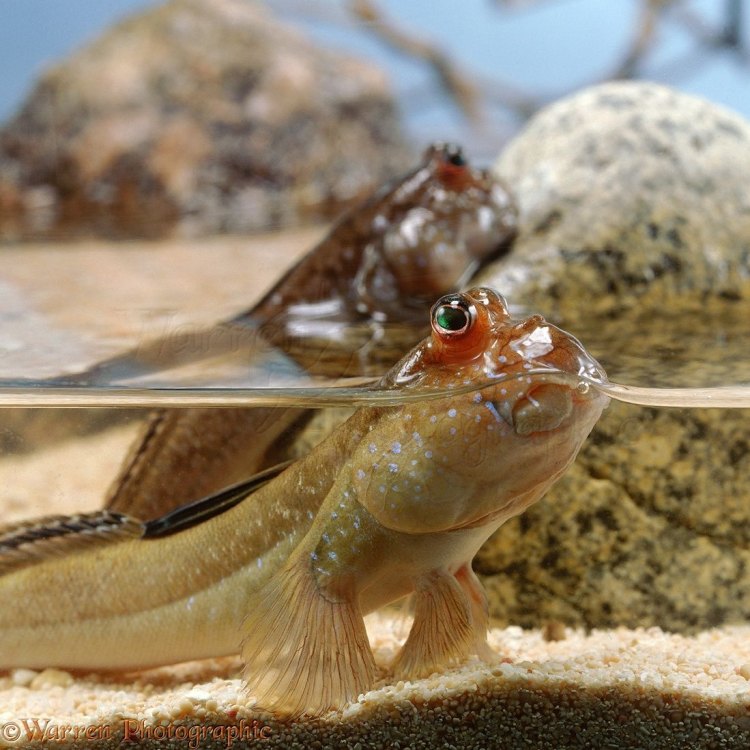
Mudskipper
- Adult Size: Around 8 to 20 centimeters
- Average Lifespan: Around 3 to 5 years
- Reproduction: Sexual reproduction
- Reproductive Behavior: Males attract females by performing visual displays and vocalizations
- Sound or Call: Males produce drumming sounds using their pectoral fins
- Migration Pattern: Non-migratory
- Social Groups: Solitary or small groups
- Behavior: Capable of breathing air and can move on land using their pectoral fins
- Threats: Habitat destruction, pollution, and overfishing
- Conservation Status: Varies depending on the species
- Impact on Ecosystem: Important in the food chain and as indicators of ecosystem health
- Human Use: Used as a food source in some cultures
- Distinctive Features: Ability to breathe air and move on land
- Interesting Facts: Mudskippers have specialized gill chambers that allow them to extract oxygen from the air
- Predator: Birds, larger fish, and reptiles
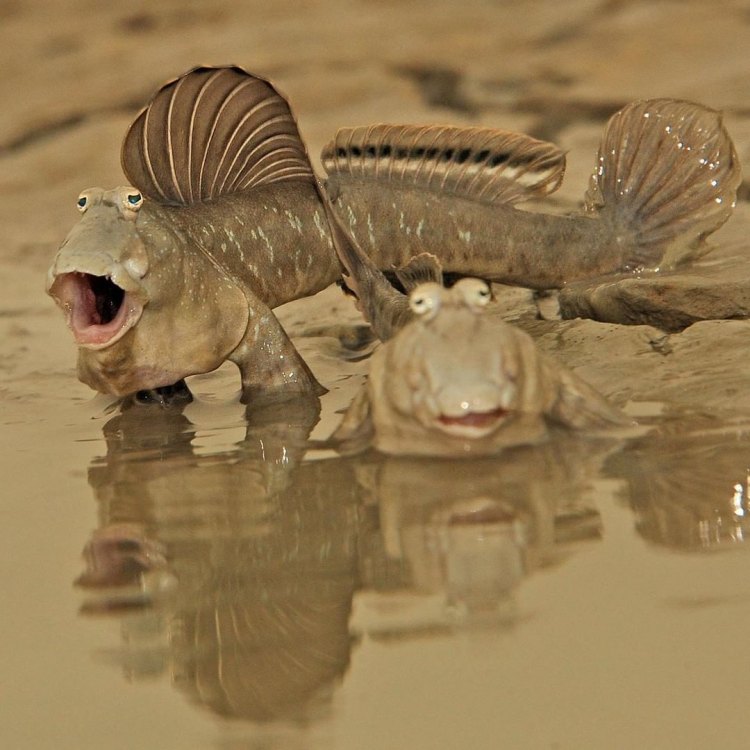
Periophthalmus
The Incredible World of Mudskippers: Masters of Land and Sea
In the vast and diverse world of marine life, there are many creatures that capture our attention with their unique abilities and appearances. One of these remarkable creatures is the mudskipper, a small but mighty fish that has evolved to survive in both water and on land. With its distinctive features and fascinating behaviors, the mudskipper is truly a special species worth learning about.Standing at only 8 to 20 centimeters in length, the mudskipper may appear unassuming at first glance PeaceOfAnimals.Com. But do not let its size fool you, as this tiny fish has some amazing capabilities and qualities that set it apart from other marine animals. Let's dive deeper into the world of mudskippers and discover what makes them such remarkable creatures.
The Basics: Size, Lifespan, and Reproduction
Mudskippers are found in tropical and subtropical regions, with the majority of them inhabiting the Indo-Pacific region. They are typically small in size, ranging from 8 to 20 centimeters in length when fully grown. However, there are some species, like the giant mudskipper, that can grow up to 35 centimeters in length.The average lifespan of mudskippers is around 3 to 5 years. This may not seem very long, but considering their relatively small size and the many threats they face, it is actually quite impressive.
Reproduction in mudskippers is done through sexual reproduction like most other fish species. However, the reproductive behavior of mudskippers is quite interesting, as males have developed unique ways to attract females Masked Angelfish. They do this by performing intricate visual displays and vocalizations to catch the attention of potential mates.
Mudskippers: Masters of Sound and Movement
Mudskippers are known for their ability to produce drumming sounds using their pectoral fins. These sounds are used as part of their reproductive behavior to attract mates, but they also have other purposes. Mudskippers may also use these sounds to communicate with each other or as a warning signal in case of danger.But what is truly impressive about mudskippers is their movement on land. Unlike most fish, mudskippers are not restricted to water and can actually move around on land. They achieve this by using their pectoral fins as "legs," propelling themselves forward in a hopping motion. This unique adaptation allows mudskippers to navigate between pools of water, rocks, and even up onto higher surfaces.
Non-Migratory and Solitary
While some fish species may migrate to different areas for breeding or feeding, mudskippers are non-migratory. This means they stay in one location for most of their lives, usually in mangrove forests or intertidal mudflats.As for their social behavior, mudskippers are not typically known to be social creatures. They are mostly solitary, only coming into contact with other mudskippers during breeding season or when competing for territory.
Threats: Habitat Destruction, Pollution, and Overfishing
Like many other marine animals, mudskippers face multiple threats to their survival in the wild. The destruction of their natural habitat, mainly due to coastal development and pollution, is a major concern. Mangrove forests, where mudskippers often live, are being destroyed at an alarming rate, leaving them with less space to thrive and reproduce.Overfishing is another major threat to mudskippers. While some cultures may use them as a food source, commercial overfishing for the aquarium trade has also become a problem. This can have a significant impact on the population and disrupt the delicate balance of their ecosystem.
The Importance of Mudskippers in the Ecosystem
Mudskippers play an essential role in the ecosystem, especially in their coastal habitats. They are a vital link in the food chain, as both predators and prey. They feed on small insects, crustaceans, and other invertebrates, and are themselves eaten by larger fish, birds, and reptiles.Aside from their role in the food chain, mudskippers also serve as indicators of ecosystem health. If there is a decline in their population, it could be a sign that something is wrong with their habitat and the surrounding ecosystem.
Conservation Status and Human Use
The conservation status of mudskippers varies depending on the species, with some being listed as vulnerable or endangered. The destruction of their habitat and overfishing have led to a decline in their population, making conservation efforts crucial for their survival.In some cultures, mudskippers are used as a food source. However, it is important to ensure that their harvesting is done sustainably to avoid depleting their population and damaging the ecosystem.
Fascinating Facts about Mudskippers
Aside from their unique abilities and behaviors, there are many fascinating facts about mudskippers that make them stand out even more. One of these is their specialized gill chambers, which allow them to extract oxygen from the air. This adaptation allows them to remain out of the water for extended periods, making them true masters of land and sea.Another fun fact about mudskippers is that they are known to be quite territorial and will fiercely defend their chosen territory from other mudskippers. They do this by making displays, vocalizations, and even fighting if necessary.
Predators of Mudskippers
As with most animals, mudskippers have predators that pose a threat to their survival. The most significant predators of mudskippers are birds, larger fish, and reptiles, such as snakes and monitor lizards. Being able to move on land gives mudskippers an advantage in avoiding these predators, but it does not make them completely immune to their attacks.In Conclusion, the mudskipper is truly a remarkable and unique creature that has evolved to thrive in both land and water. Their distinctive features and fascinating behaviors make them stand out among other marine animals. However, they also face numerous threats that put their survival at risk, highlighting the importance of conservation efforts to protect these incredible creatures. So the next time you see a mudskipper, take a moment to appreciate their resilience and incredible abilities that make them true masters of land and sea.
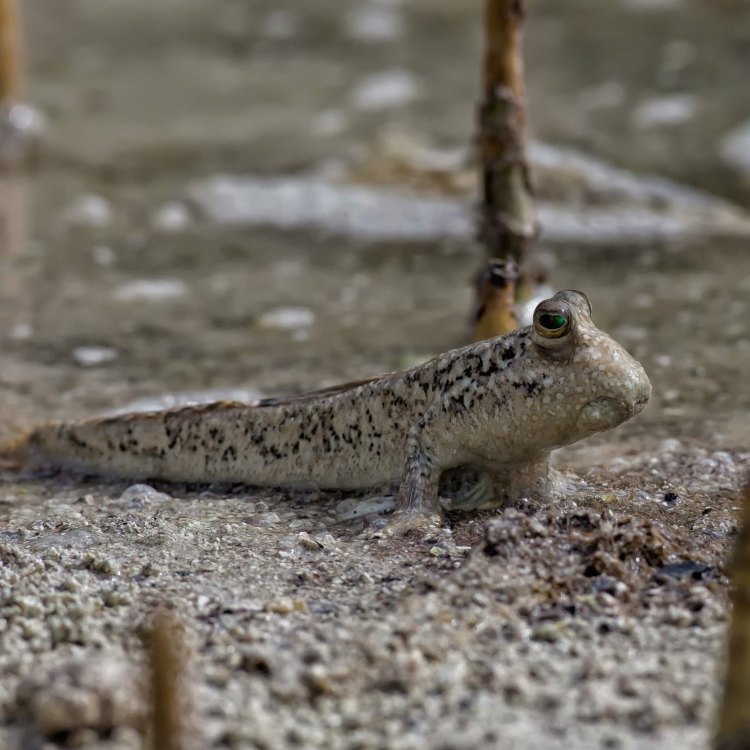
Mudskippers: The Incredible Amphibious Fish
Disclaimer: The content provided is for informational purposes only. We cannot guarantee the accuracy of the information on this page 100%. All information provided here may change without prior notice.

